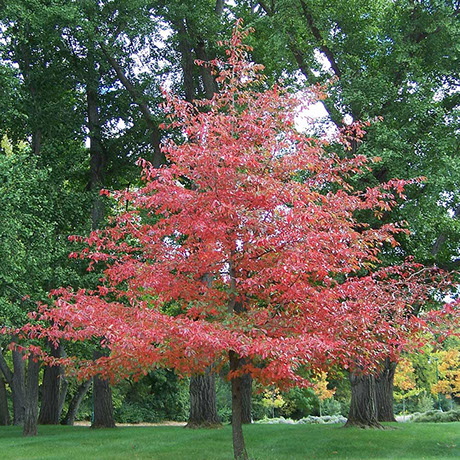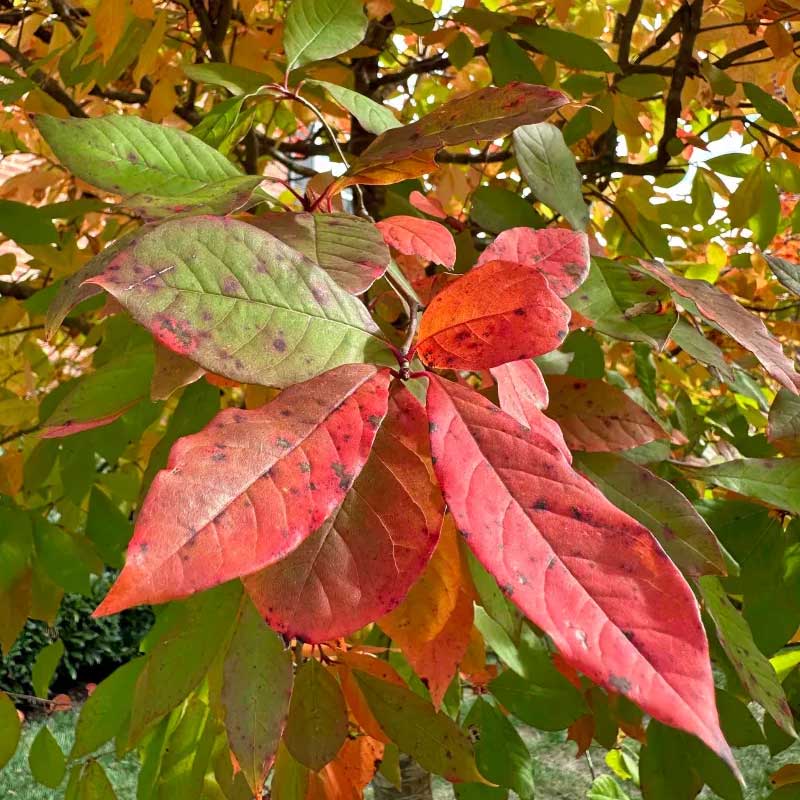The science of preserving nature since 1964
Trees to Consider:
Black Gum (Nyssa sylvatica)
The Black Gum, also known as Black Tupelo, is one of the most underappreciated yet stunning native trees in the northeastern United States. Renowned for its glossy summer foliage and vibrant fall color —ranging from deep scarlet to orange and yellow — the Black Gum adds year-round visual interest and ecological value to the landscape. Its horizontal branching and pyramidal form provide a unique structural silhouette, while its small, inconspicuous spring flowers serve as an early nectar source for pollinators.
This species thrives in well-drained, acidic soils and is tolerant of a wide range of moisture conditions, from dry uplands to moist bottomlands. Black Gums are extremely hardy and long-lived, with strong wood that makes them resistant to storm damage. They are slow-growing but reward patient homeowners with decades of beauty and minimal maintenance. Mature trees typically reach 30–50 feet tall, though larger specimens are not uncommon in optimal conditions.
Latin Name: Nyssa sylvatica
Common Name: Black Gum, Black Tupelo
Tree Type: Native deciduous shade and ornamental tree.
Flower and Foliage: Black Gum trees produce small greenish-white flowers in spring that attract bees and other pollinators. The leaves are simple, oval-shaped, and glossy green in summer, turning brilliant shades of red, orange, and yellow in the fall — often on the same branch — making it one of the most spectacular fall color trees.
Sun and Water Requirements: Prefers full sun to partial shade and grows best in moist, well-drained, acidic soils. It is tolerant of seasonal flooding as well as moderate drought once established, making it adaptable to varied landscape conditions.
Expected growth: Typically reaches 30–50 feet in height with a spread of 20–30 feet. Growth is slow to moderate, with a strong central leader and a naturally symmetrical, pyramidal shape in youth that becomes more rounded with age.
Landscape Value: A four-season standout, the Black Gum offers striking fall color, glossy summer leaves, and strong branch structure. It is a valuable wildlife tree — producing small blue-black fruits relished by birds and providing nesting habitat. Ideal as a specimen tree, it also works well in naturalized plantings and woodland edges.
Care: Black Gums require minimal pruning and are relatively pest- and disease-resistant. Mulching helps retain soil moisture and protect surface roots. Avoid overly alkaline soils and mechanical injury to the trunk. With proper siting and care, this native tree offers decades of beauty and resilience.



LOCATIONS:
Lower Westchester County, NY and New York City
58 Beechwood Ave, New Rochelle, NY 10801
914-576-0193
Upper Westchester (North of I-287)
15 Broadway, Hawthorne, NY 10532
914-741-1510
Fairfield County, Connecticut
547 Hope Street, Stamford CT 06907
203-348-4111
Bergen & Passaic Counties, NJ
504 High Mountain Road, North Haledon, NJ 07508
973-636-6711
Contact us for a Free Consultation
